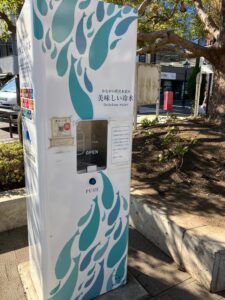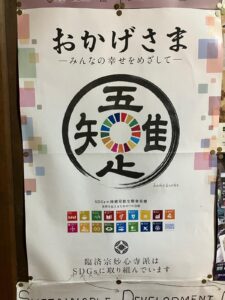
Writing a project proposal can be creative and collaborative. In the not-so-distant past, it was not unusual to include buzzwords (gender, environment, SMEs, to name a few) without thinking clearly about how the project was relevant and, quite bluntly, proposals containing “padding” and ” hot air.”
Adopting Agenda 2030, the Sustainable Development Goals and associated Human Rights have changed the game. For example, you can no longer design a gender project by mentioning SDG 5; you will need to examine the relevant targets, indicators, and associated human rights; here’s why!
But first, let’s look at some examples of how the Japanese make their public aware of the SDGs and obligations.



The first two photographs show the Kamakura station and the water fountain, which informs the public of the SDGs and the need to save water,
The second photo is of the entrance to the Zen Monastery of Ryoan-ji, Kyoto’s most famous zen garden. It explains the similarity between Buddhist beliefs and the SDGs, emphasizing kindness and civility to others.
Back to Europe!
The European Commission and United Nations bodies have robust mechanisms to monitor and evaluate project proposals and their implementation to ensure they align with the Sustainable Development Goals (SDGs) and human rights (HR) criteria.
These processes involve rigorous ex-ante evaluations, ongoing monitoring, and ex-post assessments to ensure that projects contribute positively to sustainable development while upholding fundamental human rights. These mechanisms track progress and provide accountability and transparency in using funds and achieving global goals. Remember, we are talking about global sustainability, including EU Member States.
- European Commission Monitoring and Evaluation Framework
The European Commission uses a structured monitoring and evaluation (M&E) framework to assess project proposals and implementation. This framework ensures that projects funded by the EU align with EU policies, including the SDGs and human rights principles.
Key Components:
- Ex-Ante Evaluation: Before project approval, proposals are evaluated against criteria relevant to EU policies, including the SDGs and human rights. This involves assessing the project’s potential impact on the environment, society, and economy.
- Ongoing Monitoring: Once a project is approved, its implementation is closely monitored through regular reports, site visits, and stakeholder consultations to ensure it continues to align with the SDGs and HR criteria.
- Ex-Post Evaluation: After project completion, an evaluation is conducted to assess its impact, sustainability, and contribution to the SDGs and human rights.
Concrete Example:
- Horizon 2020 Program: Under the Horizon 2020 framework, project proposals must demonstrate how they contribute to the SDGs, mainly through innovation in climate action, sustainable energy, and health. During the evaluation, independent experts assess the proposals against criteria like societal impact, environmental sustainability, and ethical considerations, which include human rights.
- Implementation Monitoring: Throughout the project, beneficiaries must submit periodic reports detailing progress towards the objectives, adherence to ethical standards, and contributions to the SDGs. The European Commission may conduct audits or site visits to verify the information.
- Evaluation Example: A project focusing on renewable energy innovation might be evaluated on its contribution to SDG 7 (Affordable and Clean Energy) and its impact on communities, ensuring no human rights are violated (e.g., rights of local communities in project areas).
Erasmus+ Programme
Erasmus+ is a flagship EU program that supports education, training, youth, and sport. It promotes SDG and human rights-related goals through cross-border collaboration, learning, and capacity-building initiatives.
Key Components:
- Project Proposal Evaluation: Erasmus+ projects are evaluated based on their alignment with EU objectives, including promoting equity, inclusion, and social cohesion. Proposals must demonstrate how they contribute to relevant SDGs and uphold human rights principles, such as the right to education (SDG 4) and gender equality (SDG 5).
- Monitoring of Project Implementation: The Erasmus+ National Agencies monitor the progress of funded projects, ensuring that they meet their objectives and contribute to the broader EU goals related to the SDGs and human rights. This includes regular reporting and site visits.
- Impact Assessment: At the end of the project, an impact assessment is conducted to evaluate the effectiveness of the project in achieving its goals, including its contribution to SDGs and the promotion of human rights.
Concrete Example:
-
Youth for Climate Action Initiative: This project, funded under Erasmus+, aims to educate and engage young people on climate change (SDG 13). It was evaluated on its ability to empower youth to take climate action while promoting human rights, such as the right to a healthy environment.
-
Implementation Monitoring: The project was monitored through participant feedback, progress reports, and site visits, ensuring it met its educational goals and effectively engaged young people in climate activism.
-
Evaluation Example: The project was evaluated on its impact on participants’ awareness and actions regarding climate change and on how it fostered inclusivity and respect for the rights of all participants, particularly marginalized youth.
-
- Structural Funds and Cohesion Policy
The European Commission also uses its Structural Funds and Cohesion Policy to support projects contributing to sustainable development and reducing regional disparities within the EU.
Key Mechanisms:
- Thematic Objectives: Projects funded under these mechanisms must align with thematic objectives that directly correspond to the SDGs, such as promoting sustainable transport, combating climate change, and fostering social inclusion.
- Partnership Agreements: Member States must enter into Partnership Agreements with the European Commission, outlining how they will use EU funds to achieve the SDGs and respect human rights.
- Operational Programs: These programs set out specific actions and measures to be taken at the national or regional level, with clear indicators for monitoring progress towards SDG-related goals.
Concrete Example:
- European Regional Development Fund (ERDF): Projects funded by the ERDF must contribute to at least one of the SDGs’ thematic objectives, such as improving energy efficiency (SDG 7) or supporting social inclusion (SDG 10). The project proposal process thoroughly assesses how the project will address these objectives.
- Implementation Monitoring: The European Commission monitors implementation through annual and final reports submitted by the managing authorities and the use of indicators and targets that align with SDG metrics.
- Evaluation Example: A project aimed at improving public transportation in a disadvantaged region might be evaluated on its contribution to SDG 11 (Sustainable Cities and Communities) and its impact on vulnerable populations, ensuring their right to mobility and access to services is upheld.
- United Nations Bodies Monitoring and Evaluation
- UNDP (United Nations Development Programme)
UNDP plays a key role in supporting countries in localizing the SDGs and incorporates rigorous M&E processes to ensure project alignment with the SDGs and human rights.
Key Components:
- Social and Environmental Standards (SES): UNDP projects must adhere to SES, ensuring that projects do not harm the environment or violate human rights. This includes impact assessments and stakeholder engagement processes.
- Results-Based Management (RBM): UNDP employs RBM to ensure projects are designed with clear outcomes related to the SDGs and human rights. Indicators are developed to measure progress towards these outcomes.
Concrete Example:
- UNDP’s Small Grants Programme (SGP) supports community-based projects that contribute to sustainable development and human rights. Proposals are evaluated based on their potential to achieve SDG-related outcomes and their respect for human rights.
- Implementation Monitoring: Projects are monitored through site visits, progress reports, and stakeholder consultations to ensure they meet their SDG and human rights objectives.
- Evaluation Example: A project focused on protecting Indigenous lands might be evaluated based on its contribution to SDG 15 (Life on Land) and protecting Indigenous peoples’ rights, ensuring their right to land and resources is respected.
- UNICEF (United Nations Children’s Fund)
UNICEF integrates SDG and human rights monitoring into its projects, particularly those focusing on children’s rights and well-being.
Key Components:
- Human Rights-Based Approach (HRBA): UNICEF uses HRBA to ensure all projects respect and promote the rights of children as outlined in the Convention on the Rights of the Child, which aligns with SDG objectives like quality education (SDG 4) and reduced inequalities (SDG 10).
- Monitoring Tools: UNICEF uses tools like the Multiple Indicator Cluster Surveys (MICS) to monitor projects’ impact on children’s well-being and progress towards the SDGs.
Concrete Example:
- UNICEF’s Education Programmes: These programs aim to achieve SDG 4 (Quality Education) by ensuring access to inclusive and equitable education for all children. Proposals are evaluated on their potential to deliver these outcomes while upholding children’s rights.
- Implementation Monitoring: Regular monitoring includes tracking attendance rates and learning outcomes and ensuring no child is discriminated against, particularly in marginalized communities.
- Evaluation Example: An education project in a conflict-affected region might be evaluated on its ability to ensure continued access to education (SDG 4) while protecting children’s rights to safety and non-discrimination.
- UNEP (United Nations Environment Programme)
UNEP focuses on projects related to environmental sustainability and incorporates SDG and human rights criteria into its monitoring and evaluation processes.
Key Components:
- Environmental and Social Safeguards: UNEP projects must comply with safeguards designed to protect the environment and the rights of communities affected by environmental projects.
- SDG Linkages: UNEP uses the SDGs as a framework for designing and evaluating projects, particularly those related to climate action (SDG 13), life below water (SDG 14), and life on land (SDG 15).
Concrete Example:
- UNEP’s Climate Adaptation Projects: These projects are designed to help communities adapt to the impacts of climate change, contributing to SDG 13 (Climate Action). Proposals are evaluated based on their environmental impact and ability to protect vulnerable populations’ rights.
- Implementation Monitoring: UNEP monitors the projects through regular field visits and environmental impact assessments to ensure they meet their SDG goals and safeguard community rights.
- Evaluation Example: A climate adaptation project might be evaluated on its effectiveness in reducing vulnerability to climate impacts (SDG 13) and its success in ensuring that the rights of affected communities, such as the right to access natural resources, are respected.
Was this information new to you? If so, here is some inspiration for developing a project(s) for NGO-CSOs and stakeholders.
Public Awareness Campaigns, Presenting the VNR to the
Public and Strengthening Government Accountability and Transparency
Consult also the attached: Goal 16 Advocac y Toolkit (In English, French and Spanish)